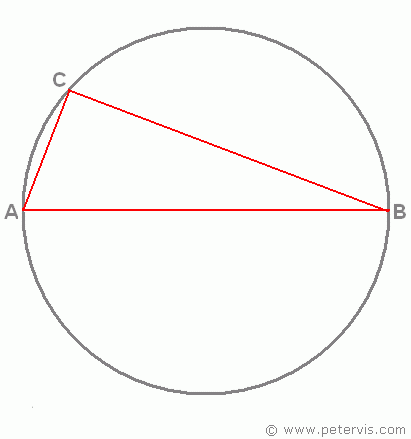Triangle Inscribed in a Semicircle

The triangle ABC inscribes within a semicircle. The angle at vertex C is always a right angle of 90°, and therefore the inscribed triangle is always a right angled triangle providing points A, and B are across the diameter of the circle. The area within the triangle varies with respect to its perpendicular height from the base AB. There is only one point when the triangle will have the largest area.
Maximum Area of Triangle

Finding the maximum area, or largest triangle, in a semicircle is very simple. At first you might think that there is not enough information, but remember that they want the maximum area. The triangle is the largest when the perpendicular height shown in grey is the same size as r. This is when the triangle will have the maximum area.

The formula ½× b × h is the area of a triangle, and in this case, the base is double the radius or 2r. Since the base sits on the diameter of the semicircle, the height is r, and the following formula provides the area.
A = ½× 2r × r
A = r²
Example Question
If the diameter BC was 10 cm, and r = 5 cm, what is the largest triangle inscribed within the circle?
Answer
Maximum Area = 5²
A = 25 cm²
Maximum Area Calculator
Proof

Prove angle ACB is 90°: This is easy as there are two isosceles triangles sharing the same length of radius for their sides. Let us call the angle at vertex C angle c, the angle at Vertex A, angle a, and the angle at vertex B, angle b.

The angles in a triangle add up to 180°, therefore a + b + c = 180°. However, triangle AOC is an isosceles triangle where two of its sides are r. Therefore angle ACO is a.
Similarly, triangle OBC is also isosceles because of two identical sides of length r. Therefore, angle BCO is b.
This means that angle ACB is the sum of two angles, a, and b. Hence, c = a + b.

Since angle c = a + b, we can substitute it into the formula a + b + c =180, to give the above expression.

Simply factorising out the 2 gives final stage.

QED
History
The study of triangles and quadrilaterals inscribed within a semicircle is not new. Man first studied it in ancient India. The Babylonians also studied similar effects however; they did not have a concept of measuring angles. Nevertheless, almost every civilisation had a go at this at some point using a short piece of chord.